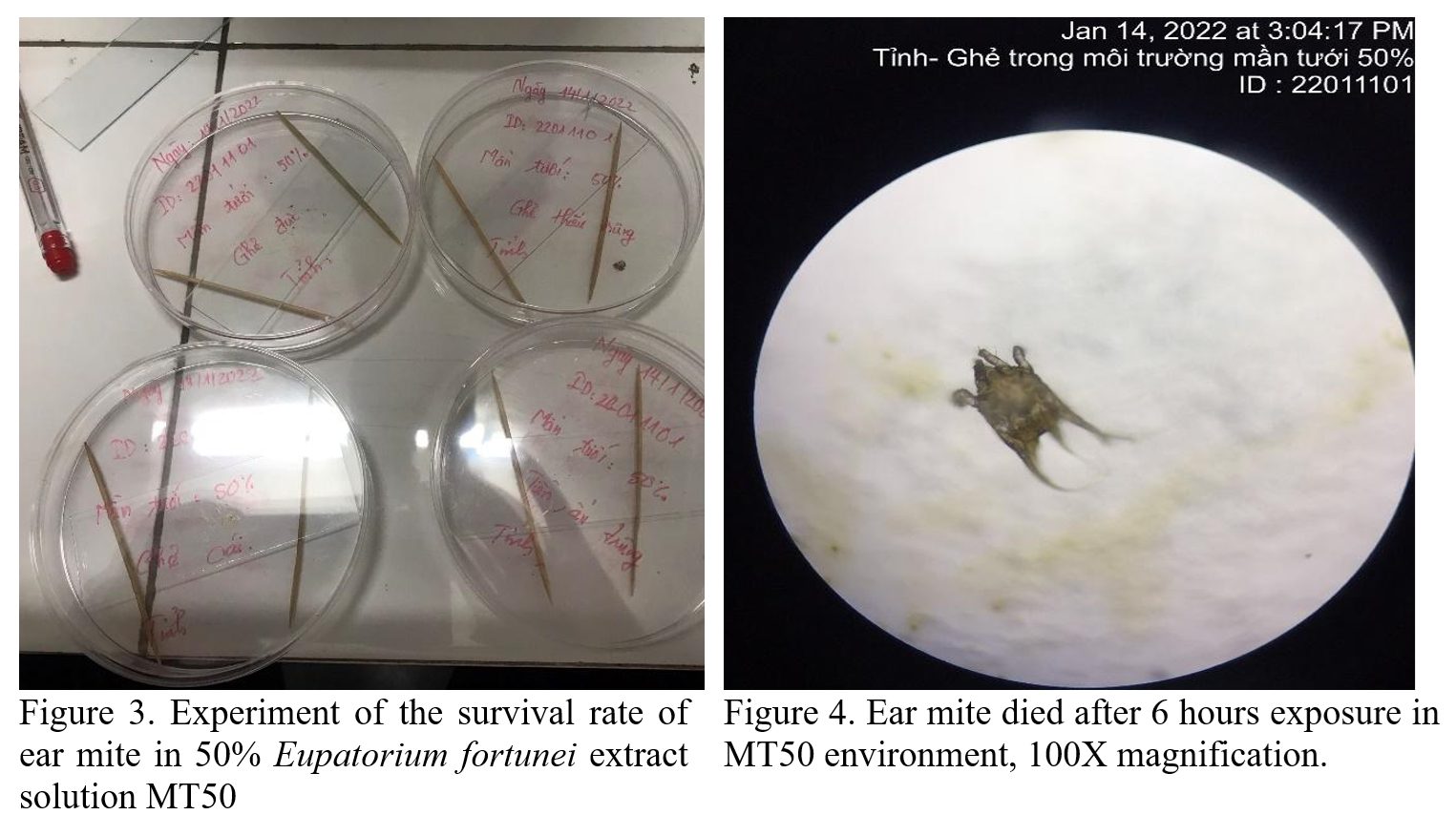Nguyen Van Phuong
1. Introduction
Currently, there are many medications approved for the treatment of ear mite infections caused by O. cynotis in cats and dogs, including topical solutions and oral medications. Worldwide, there is a growing trend towards using natural remedies, with herbal-based treatments increasingly popular due to their alignment with the body’s physiology and minimal harmful effects. For instance, Rosemary has been found to be effective in killing D. minutusin (Zoral et al., 2017), and Derris elliptica extract is known to kill Lipaphis erysimi aphids (Hu MY, 2005). However, no studies have investigated the effects of these herbs on ear mite infections in Vietnam. Thus, this study aims to evaluate the survival of O. cynotis in herbal environments under laboratory conditions, providing a foundation for future research into the effectiveness of herbal treatments for ear mite infections in cats and dogs.
2. Materials and methods
2.1. Research Materials
The materials used in the study included:
- Earwax samples from cats;
- Olympus CX23 optical microscope, slides, petri dishes, dissecting needles, thermohygrometer, pipettes, digital watch,
- Eupatorium fortunei, Rosemary, Derris elliptica plants, glass funnels, volumetric flasks, GT Sonic ultrasonic shaker, BUCHI I-300 rotary evaporator, LABCONCO freeze dryer, drying machine, distilled water, absolute ethanol, and 70% ethyl acetate (EA);
- The research was conducted from January 2022 to December
2.2. Research Location
The research was conducted at the Parasitology Laboratory, Faculty of Veterinary Medicine, and the Environmental Faculty Laboratory, Vietnam National University of Agriculture.
2.3. Research Methods
2.3.1. Collection, transportation, and storage of samples
The targeted sampling method was used. Cats and dogs with symptoms such as brown earwax, frequent head shaking, and ear scratching were selected for earwax sample collection at veterinary clinics in Hanoi. Earwax was collected using a cotton swab from both ears of the animals
2.3.2. Preparation of dried extract and herbal extracts
Three herbs were tested: Eupatorium fortunei, Rosemary, and Derris elliptica. dried extract and herbal extracts were prepared following the procedure of Dinh et al., 2020. The herbal extract used in the study was prepared in a ratio of [50% dry extract powder: 50% 70% Ethyl Acetate solution].
2.3.3. Experiment Experiment on ear mite survival in laboratory condition and in herbal environments
The number of live and dead mites in each condition was recorded. The following herbal environments:
- 50% Eupatorium fortunei extract solution: MT50
- 50% Rosemary extract solution: HT50
- 50% Derris elliptica extract solution: TC50
Live mites were those that showed mobility, while dead mites were those that no longer moved, even when stimulated with a dissecting needle.
3. Results and discussion
3.1. The survival rate of ear mites O. cynotis in laboratory conditions
The survival rate of ear mites O. cynotis at various developmental stages was monitored under laboratory conditions with a temperature range of 28 – 33°C and humidity of 72 – 85%.
Key Findings:
- Maximum Lifespan: In laboratory conditions, the maximum lifespan of the mites was 6 days. By the 7th day, all the mites had died. Among these, adult female mites had the highest survival rate on day 6, with only 1.3% still alive.
- Survival Trend: During the first 6 hours, all mites remained alive. However, they began to die after the 6-hour mark. On day 1, the survival rate of female mites was 74.05%, while male mites had a lower survival rate of 65.36%. By day 5, survival rates had decreased significantly across all stages:
-
- Male mites: 1.45% alive
- Female mites: 3.08% alive
- Deutonymphs: 2.91% alive
- Protonymphs and larvae: 1.42% alive
- On day 7, no mites from any stage were still alive.
- Environmental Factors: The survival rates of mites decreased over time due to the lack of food sources and the artificial environmental conditions (temperature and humidity) that were not conducive to the natural habitat of the mites. This is consistent with previous studies, such as Otranto et al. (2004), which found that mites at 34°C could survive for only 5 to 6 days.
- Female Mites: The lifespan of adult female mites was notably longer compared to other developmental stages.
3.2. The survival rate of O. cynotis ear mites at different developmental stages in herbal extract solution environments
Based on the experimental results, the 50% Eupatorium fortunei extract solution showed the highest efficacy in killing ear mites, with 100% of the mites dying within the first 24 hours. The 50% Derris elliptica extract caused complete mortality of the mites before 48 hours. Finally, in the 50% Rosemary extract solution environment, the mites could survive until the second day of the experiment.
4. Conclusion
- The study results indicate that under laboratory conditions, the maximum survival time of cynotis ear mites is 6 days, with all mites dying by the seventh day. Among them, the highest survival rate on day 6 was 1.3% for adult female mites.
- The herbal extract solutions used in the study all showed certain effects in killing cynotis ear mites. The MT50 solution was the most effective, with most mites dying within the first 6 hours and complete mortality occurring before 24 hours. When tested with the TC50 solution, only 6.28% of female adults and 1.00% of deutonymphs survived after 24 hours, and all ear mites died before 48 hours. In the HT50 solution, adult mites could survive up to 48 hours, while mites in the immature stages only survived up to 24 hours.
- These results suggest promising potential for using herbal extracts from Eupatorium fortunei, Derris elliptica, and Rosemary in clinical treatments for dogs and cats infected with cynotis ear mites.
Appendixes




 English
English